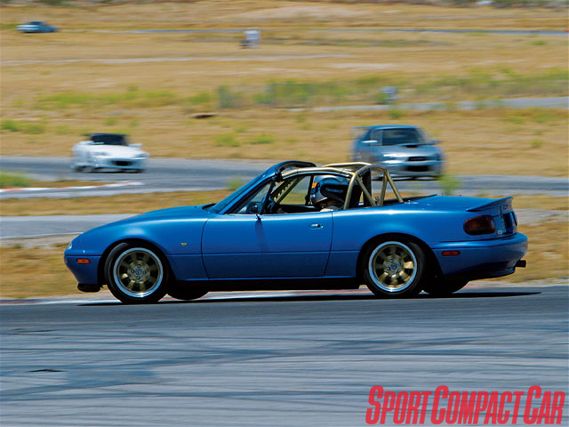 | Project Time Attack Part 1 - Project Miata Is Dead
| Project Time Attack Part 1 - Project Miata Is Dead
Last time we saw Project Miata, our ears were still ringing from the sound of old folks playing the slots in Vegas. There is nothing more humiliating than knowing Project Miata was stolen (again) and not being able to convince casino security that we weren't too drunk the night before to remember where we parked our hairdresser-mobile. We wondered whether Project Miata should die then and there, but we're gluttons for punishment. And this time we're going to do it differently.
Project Miata is dead. Long live Project Time Attack. Apparently, glorified time trials are the new black. And since we like to be fashionable in our own dorky way, we're taking our theft-recovery racing.
It seems like we've been in the initial stages of making a fast Miata so many times we're beginning to think we're stuck in a Bill Murray movie. But let's get the foundation built first: to be fast, you need to be safe.
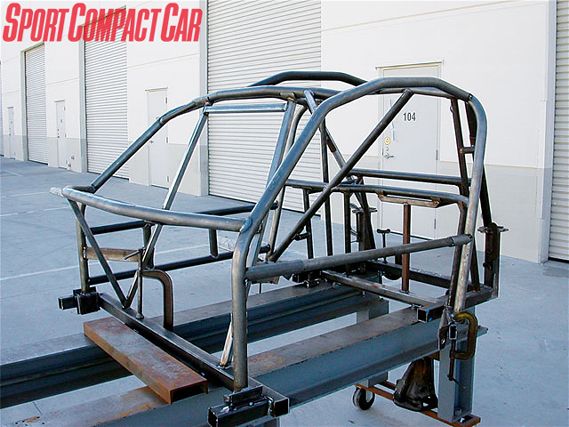 | Before the pieces of the cage were test-fitted in the car, it was assembled on a jig. After getting everything tacked in place in the car, it was removed (again) and put back on the jig to have all the seams welded.
| Before the pieces of the cage were test-fitted in the car, it was assembled on a jig. After getting everything tacked in place in the car, it was removed (again) and put back on the jig to have all the seams welded.
Now that we're making it primarily a track car of the stupid-fast variety, our Time Attack Miata and driver need a full update of safety equipment. We plan on building a car that can compete in multiple organizations' events, so we need to accommodate as many sanctioning rule books as possible. Time attack rules are generally not as stringent as wheel-to-wheel racing requirements, since most racing organizations have had time trial events for years.
The National Auto Sport Association (NASA) uses its time trial rules and classifying structure for the time attack events it helps sanction. NASA's safety requirements are outlined more intensely than any of the other major time attack organizations, so these are our guidelines. However, they will only serve as our base - we will be going far beyond.
Roll Cage
For a convertible to participate in any of NASA's events, a rollbar is the minimum requirement for roll over protection. For the speeds and power this Miata will be capable of, we're not comfortable with the minimum, so we're installing a full NASA race-spec roll cage.
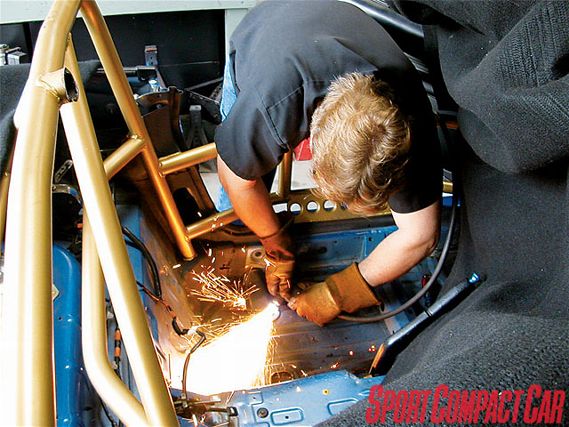 | We used a plasma cutter to remove the rear seat mount pedestals in order to get the seat as low as possible.
| We used a plasma cutter to remove the rear seat mount pedestals in order to get the seat as low as possible.
According to NASA rules, a roll cage for a car weighing 2200-plus pounds only requires 1.5-inch diameter tubes with a 0.12-inch wall thickness. Although we hope to end up with a car that's below 2200 pounds, we are going to err on the safe side and use the 2200-plus spec.
Few people know roll cages for Miatas better than Tony Woodford of AWR in San Diego, California. Not only has AWR been providing Spec Miata cages for years, it is the sole provider for the new Pro-Spec MX-5 series. You've seen Tony's work on TV in the Speed World Challenge. Not wanting to leave well enough alone, the Spec Miata cage was given a few tweaks to better suit our safety-first purposes.
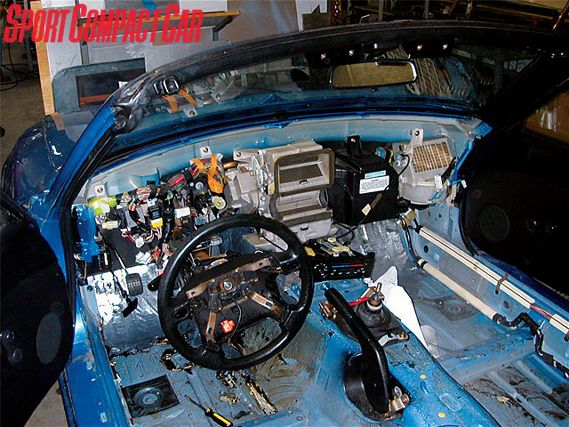 | You want to build a cage that is as far toward the outer edges of the passenger compartment as possible. This increases chassis rigidity as well as driver safety. In order to do so, you need to strip the whole interior.
| You want to build a cage that is as far toward the outer edges of the passenger compartment as possible. This increases chassis rigidity as well as driver safety. In order to do so, you need to strip the whole interior.
When we brought the car in, the first step was to strip the interior. As we removed the carpeting, we discovered the previous owner was kind enough to Dynamat the whole car. Woodford smiled, handed us a scraper, some acetone, a chunk of dry ice and said: "Have a party." It took almost two days of knuckle busting to get that crap off. Not removing the material from the car would have caused problems when welding onto the floorpan, as even Dynamat becomes combustible under the heat of a welding torch. We weren't looking to add 'burned to the ground' to a project history that includes vandalism and theft.
The cage starts life as a confusing pile of bent tubing, pieced together multiple times, then removed for welding, adjustment, or perhaps just for our personal aggravation. This process ensures the best possible fit.
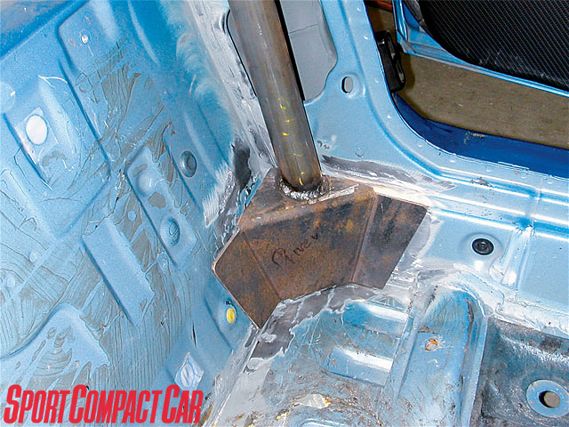 | In the event of a rollover, the pedestals supporting the cage need to distribute the weight into the chassis rather than punching a whole straight through it. The pedestal thickness and mounting, in addition to the cage itself, all have to be made to the sanctioning body's specifications.
| In the event of a rollover, the pedestals supporting the cage need to distribute the weight into the chassis rather than punching a whole straight through it. The pedestal thickness and mounting, in addition to the cage itself, all have to be made to the sanctioning body's specifications.
As driver safety and chassis strength is paramount and non-negotiable, we elected to fit AWR's standard door bars, requiring the removal of the driver's window. The door bar protrudes a couple of inches into the door area to give added deflection space before the cage intrudes into the driver's pelvis in the event of a side impact.
If it's steel or chromoly, a cage adds weight in exchange for improvements in rigidity. We originally intended to build the cage to NASA class regulations for Spec Miata, but this falls outside, because of the additional attachment points that make it as stiff and safe as possible. With what we have planned, it won't meet the requirements for this wheel-to-wheel class anyway. The cage has eight points, as well as being attached on all three edges of the door sills with gussets reinforcing both A-pillars, and above and below the windshield. Per the NASA rule book, the seventh and eighth points attach to the firewall and have 360-degree welds at their mounting plates. These additions have turned our flexi flier into a car that can lift three wheels off the ground by putting a jack under one corner.
AWR has also made provisions for a window net and kill switch. This will be required for the class this car will end up in, but not for NASA's TT street classes.
Padding
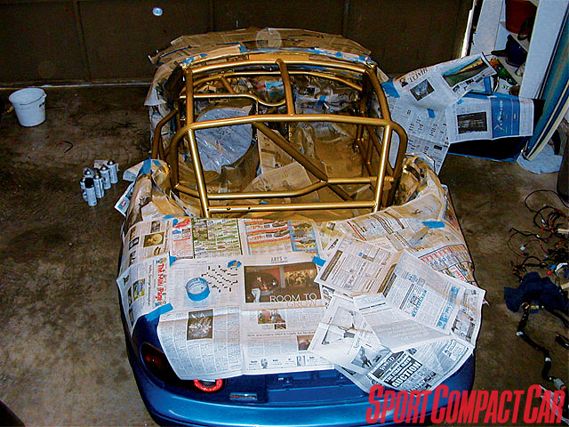 | Time required to mask off the cage: four and a half hours. Time to apply seven cans of Krylon: two hours. Time elapsed before we scratched it: four minutes.
| Time required to mask off the cage: four and a half hours. Time to apply seven cans of Krylon: two hours. Time elapsed before we scratched it: four minutes.
Most of you have seen a moron driving a car with a cage, a stock seat, and no rollbar padding. For those of you who weren't sure, we assure you that mild steel has more tensile strength than your skull. You should avoid driving on the street in a cage-equipped car with no helmet. Also, when on the track, your helmet needs some help protecting you from the cage. NASA requires use of rollbar padding made of Ethafoam or Ensolite on any part that may come into contact with the driver. It recommend SFI 45.1 spec roll bar padding, so this is what we are using.
Seats And Mounting
With a maze of hard metal bars around you, it is extremely important to have a safe seat working with the race harness to keep your body from contorting itself around the curvature of the cage. We turned to Racetech, a sponsor of the SCCA MX-5 Cup Series, for our mount. Racetech offers seats that fit into every Miata. We used its RT4009 Head Restraint Seat. While it weighs about 20 pounds, it holds a six-foot, 175-pound driver comfortably. Prior to picking the seat, we tested it to make sure the harness holes on the seatback weren't lower than the driver's shoulder height. Often neglected, the position of the holes contributing to the harness angle can be extremely dangerous, as angled shoulder belts cause the spine to compress as the body moves forward in a longitudinal impact.
Equally important is proper mounting. We've seen a driver seriously injure his legs when the rails give out in an accident. You should not use stock rails to mount a race seat. They're not secure and often raise the driver's center of gravity. AWR makes a proper mount for the Racetech seat.
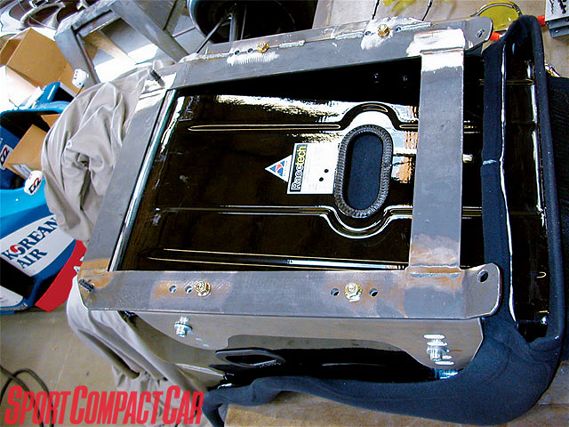 | Our custom seat bracket not only dropped the seat low, but also moved it inboard, placing the driver's head further from the cage bars.
| Our custom seat bracket not only dropped the seat low, but also moved it inboard, placing the driver's head further from the cage bars.
We used a plasma cutter to remove the stock mounting pedestals and built a mounting bracket to bolt onto the floor. In order to get the lowest possible seating position, we also heated the transmission tunnel and hammered it out of the way in a couple spots to orient the seat properly. This lower seating position not only helps lower the center of gravity, but more importantly moves the driver's head away from the roll cage. NASA's rule book has additional requirements regarding seat safety. In case of an accident, unsupported seats can break, causing severe injury. There are two ways to address this. One is to have a seatback support to help distribute the load. Proper installation will include secure attachments directly to seat and cage. The alternative, which we chose, is to select a seat that is homologated to, and is mounted in accordance with, FIA 8855-1999 standards.
Harnesses
Before we started, not much thought had gone into the difference between various harnesses. Obviously, you shouldn't use four-point belts for risk of submarining, but all five- and six-point harnesses are largely created equal, right?
A conversation with the folks at HMS Motorsports quickly answered that question. Until recently in the USA, three-inch belts were considered the safest and only legal belts to race with. In Europe, however, Schroth Harnesses (one of the leaders in safety harness technology) has been recommending two-inch lap and substrap belts, as they allow a tight and more ccurate fit.
Through the efforts of HMS (Schroth's North American distributor), many racing series are beginning to allow and endorse the smaller lap belts and substraps. HMS recommended Schroth Profi II-6 six-point belts for us.
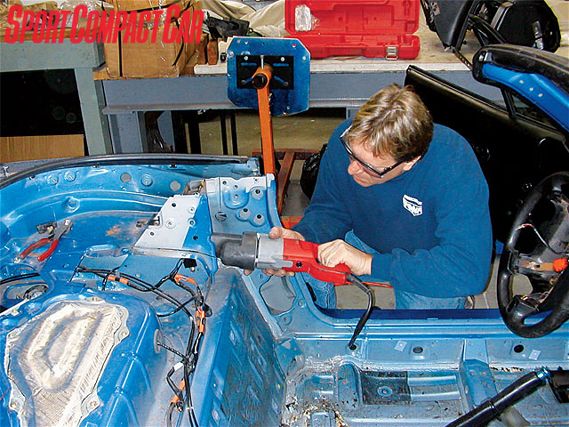 | We'll be addressing weight in the next installment. But we removed the seatbelts as well as the mounting assemblies to lessen weight as well as move the roll hoop rearward.
| We'll be addressing weight in the next installment. But we removed the seatbelts as well as the mounting assemblies to lessen weight as well as move the roll hoop rearward.
Once again, proper mounting of the harness is as important as selecting the right one. AWR added harness tabs behind our seat to keep the shoulder straps from moving. If you don't have this luxury, you should cross your harnesses behind the seat. This will keep them from sliding around and possibly loosening or sliding off your shoulder.
Fire Suppression And Prevention
It is important to note that NASA's safety rules for their High Performance Driving Experience (HPDE) and TT events do not require this much prep for most vehicles. In fact, in order to take your daily driver to the track and compete, there are only two things you will likely need to do. One is a safety inspection which goes over things you should care about on the street, like tire tread depth, brake pad thickness, and how securely the hubs are holding the wheels.
The other is a fire extinguisher, securely mounted to the metal of the car and within reach of the driver. No plastic or aerosol type cans are allowed, although there don't seem to be any provisions against chromed extinguishers. See NASA's website for allowed chemical compounds. When our car is eventually finished, we will want an integrated fire suppression system. However, NASA does not allow this system to replace a hand-held unit mounted in a location that's readily accessible to a belted-in driver.
At this point, we haven't had a chance to turn the engine bay into a rats' nest of fire hazards, so we're just using a fire extinguisher in the cabin. With all this safety work completed, we can soon get on with the serious work of going faster.
Other Installments:
Project Time Attack Part 1
Project Time Attack Part 2
Project Time Attack Part 3
